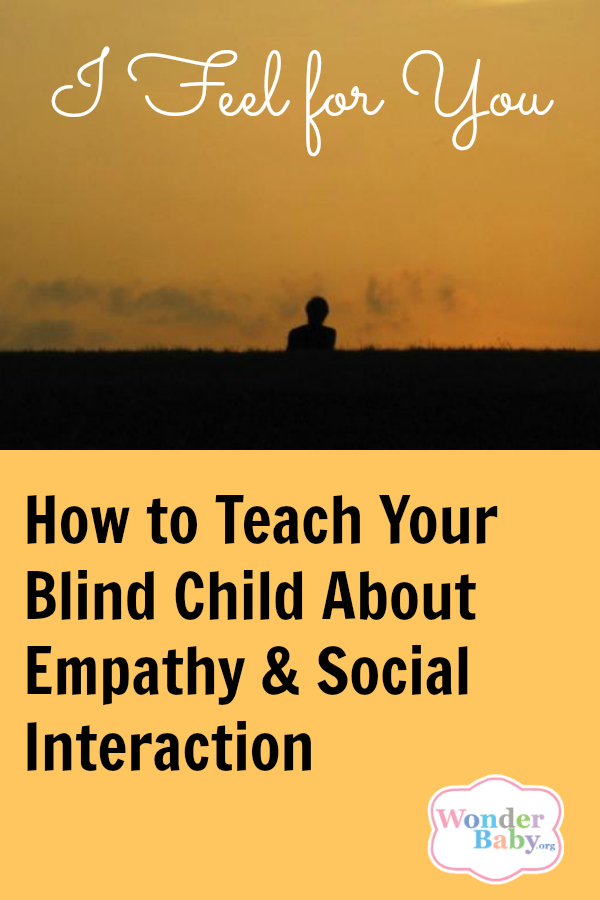I Feel for You: How to Teach Your Blind Child About Empathy & Social Interaction

What do you believe is the single most difficult thing that we as parents have to teach our children?
Could it be Toilet Training?
Teaching a child about continence can take years of cleaning up after little accidents, understanding about wet beds in the middle of the night, being patient about finding the public toilets in the supermarket for the 3rd time in a single visit.
That’s not easy.
Or are you dreading Sex Education for your little monster?
Do you worry about putting a “loaded weapon”—knowledge about human procreation—into tiny, merciless hands; living for weeks at a time with every question and enquiry into the functions of the human body complete with medically correct words?
That’s certainly a tough one.
But if your child is blind or seriously visually impaired, have you thought about how you will teach him about empathy?
Have you given consideration to how important it is to educate your child about the perspectives of others, and how critically different this learning will necessarily be to the way a sighted child would learn about it?
To be whole, happy, well-functioning members of society our children will need assistance in vast excess of that which ordinary children require, and they need us to rework and modify the lessons that sighted children receive visually every day, in order that those lessons can be of use in their primarily non-visual world.
What is Empathy & Why is it Important?
To empathize with someone is to understand how they are feeling and why they are responding a certain way. Empathy helps us to anticipate how others will react to us and makes us nicer people.
When I first began reading about empathy, I had a basic understanding of what the word meant but almost no concept of just how important it is in our everyday lives. Here’s a quick rundown:
- It is why we adore and strive to emulate some people, and despise or pity others.
- It is how we can find it in ourselves to love, judge, or even forgive the actions of others.
- It is why we open doors, both physically and metaphorically, for other people.
- It is why some actions or behaviors have the ability to disgust or delight us.
Essentially, empathy is what makes society work and it is how we come to an understanding of ourselves, by looking at the world from the perspective of another as though we were that person.
If your child is blind or visually impaired this lesson will be the most difficult, most worthwhile, and easily the most valuable thing you will ever teach him.
What the Experts Say About Empathy
Sight plays a crucial role in developing empathy. Babies begin by looking at you to see how you are feeling or reacting to a toy they are playing with or to a silly sound they just made. You’ve probably seen very young children and babies play with a toy then turn to look at their parents and if they see a smile, then they will laugh and continue playing with the toy. That’s empathy: The understanding that someone else approves of what they are doing.

A sighted child will also use pointing or gazing at an object to indicate his interest in that object, and when he sees that the same object holds both your attention and his, he can go on to examine the object and what you know about it.
Children use these simple forms of empathy to be able to assign mental states to others and themselves, to determine if a person knows a thing, or is being deceitful, or fair in a judgment, if someone is happy, or sad, or bored; fundamentally, it’s what your child needs to build a social competence.
Involved in this process is the ability to pass “false belief tasks,” as a measurement of the child’s ability to take the perspective of another. A false belief task is a test that shows us if, when a child knows a thing which someone else does not, will the child realise that the other person does not have the same knowledge that the child does?
Yes, that does sound a bit like reverse logic, but here’s a simple example: A child, John, is given a closed tube of candy wafers and asked “What is in the tube?” John answers that there is candy in the tube. The tube is opened to show the child that—surprise!—the tube actually contains buttons.
If the child is then introduced to a second child and asked, “What will Michael think is in the tube?” John will answer that Michael will think there are buttons in the tube. John at this stage is unable to differentiate what he knows from what Michael knows. He is unable to take Michael’s perspective. John has failed the false belief task.
A 1995 study indicated that blind children were often eleven years old before they could pass a false belief task that sighted children of four years old were able to pass.
How Can I Teach My Child About Empathy?
All children have to see empathy in action in order to understand it. Thankfully, sight is not absolutely essential for this message: Unfortunately, without sight the message will take longer to impart to your child because he will not have the myriad of different reinforcements of the message—but he will get there.
Psychologists and educators have spent many years researching how blind and seriously visually impaired children learn: as parents, what we need to know is that there are specific challenges our children will encounter and how to equip them most effectively to reach their potential.
- Explain everything
Your child cannot see that “picture which paints a thousand words”; so get cracking building him a word bridge into that picture. The larger his vocabulary, the better able he will be to express himself and understand others.Talk to him about his clothes, his body, how he looks to other people. Describe his world, the opportunities, the dangers, what clouds look like.A sighted child can see these things at a glance: Rendering your child’s world into words will take much longer and you may feel this approach awkward and cumbersome (lots of parents do initially) but it will soon be second nature to you.

- Give him a code of social conduct.
It is not only charming and engaging to speak to a well-mannered child, it makes his interactions with the world much more fluid and smooth. If your child will spend more time bumping into people than an ordinary child ‘Excuse me’ will be invaluable. Manners can go a long way to excusing even the most awful social faux pas.
-
- Use every opportunity.
Explain why you are taking his photograph, how you will feel looking at it, the value you place on photo’s of him, why smiling is appropriate and important when his picture is being taken, how it will enhance the picture and make you feel good and help you to remember that day. Of course you will need to tailor the language and concepts you use for your child and adapt it as he grows. Does it sound exhausting? That’s because it is!
- Use every opportunity.
-
- Talk about the why’s
Why we wear clothes.
Why we thank people.
Why lunch is in an hour’s time instead of now.
Why are cows? (Welcome to my world!)These are the questions that make you feel as though your own mind is unravelling a little bit, but it’s gotta be done!
- Talk about the why’s
-
- Give serious consideration to getting a family pet.
This is not for everyone, and I would strongly advise that the pet you consider for a blind or seriously visually impaired child is not a goldfish as it would be unlikely to survive the first examination your child gave it, but with that proviso, the responsibilities and interactions that come with having a (sturdy) pet can be invaluable for a blind youngster.
- Give serious consideration to getting a family pet.
-
- Use joint touch.
Use your hands to explore things with your child, while talking about what you can see and what you both can feel and hear and smell. Let him direct your touch, lead the exploration, find the surprises.
- Use joint touch.
-
- Let him feel your smiles.
Let him feel the small and large movements laughter gives your body, make your expressions extravagant about little disappointments and setbacks you face together, so that he has information about these things for the rest of his life.A thirty-year-old man cannot reasonably feel the faces of strangers for information, but a three-year-old can and he’ll still be using the information you gave him in eighty year’s time!
- Let him feel your smiles.
-
- Give your voice character.
Emphasize those tones and aspects of your voice that give your child an insight into your emotions. He can’t see you smiling; let him hear your smile!
- Give your voice character.

- Talk about perspective.
Let him borrow yours: Crouch with him, crawl with him, climb with him and give him the words for these activities even when they are purely visually descriptive. Show him how to place his body to be a cat, or how his little arms can mimic the movements of bird’s wings. How will he know about Hide and Seek games if he hasn’t worked out his own concept of what it is to hide? He needs your help with these bits.
-
- He needs to be naughty.
It’s what children do, so don’t be a constant silent watcher in his life—every child needs the opportunity to misbehave and learn from that behavior. Having a parent appear like an avenging angel because he doesn’t see you coming is not the way to instil in him a confidence to make decisions; right or wrong. Give him the space and sometimes the privacy to choose badly.
- He needs to be naughty.
-
- Teach him how to deal with set backs.
Give your child a way to deal with dignity and courage with those insults to his ego that he will face. I believe that this is the very hardest part of being a good parent. There will be times when your child is speaking to an empty room or thinks he is still playing with children who have already left him.You have to put your distress aside at these points in order to explain what happened, why it happened, and how he is not at fault. He needs your strength and understanding at points like these to keep going, keep enjoying the company of others, and to develop an internal belief in his own importance regardless of any other thing.
- Teach him how to deal with set backs.
- Don’t forget the constructive criticism.
People are reluctant to criticize the behavior of a blind child, that’s your job! Don’t ignore inappropriate behavior—address it and help him to change or modify it. You will be helping him to help himself and that’s what you’re there for!
Ultimately what you want for your child is what everyone wants for their children: you want to help your child to become a moral, ethical, confident person who exhibits self-control, altruism, and dignity; a happy person, comfortable in their own skin.
It’s a big job.
Don’t let us keep you!
Read this article in Arabic: حيوا-السيدة-العمياء

Related Posts

Eye Conditions and Syndromes, Visual Impairment
Neuralink Announces Plans to Restore Sight to the Blind with Brain Chip
Elon Musk’s company Neuralink has announced plans to begin human trials of its new “Blindsight” brain chip by the end of 2025.

Visual Impairment
The Gift of Understanding: How a Young Child Helps His Blind Father Navigate Life
When a parent is blind, it’s natural for people to wonder how their sighted child will adapt. Will they struggle to understand their parent’s needs? Will they feel burdened by...

Braille and Literacy, Toys, Visual Impairment
24 Braille Toys for Kids Who are Blind
Everything from alphabet blocks to raised line coloring pages and activity books to puzzles to card and board games... and so much more! And it's all in braille ready for...